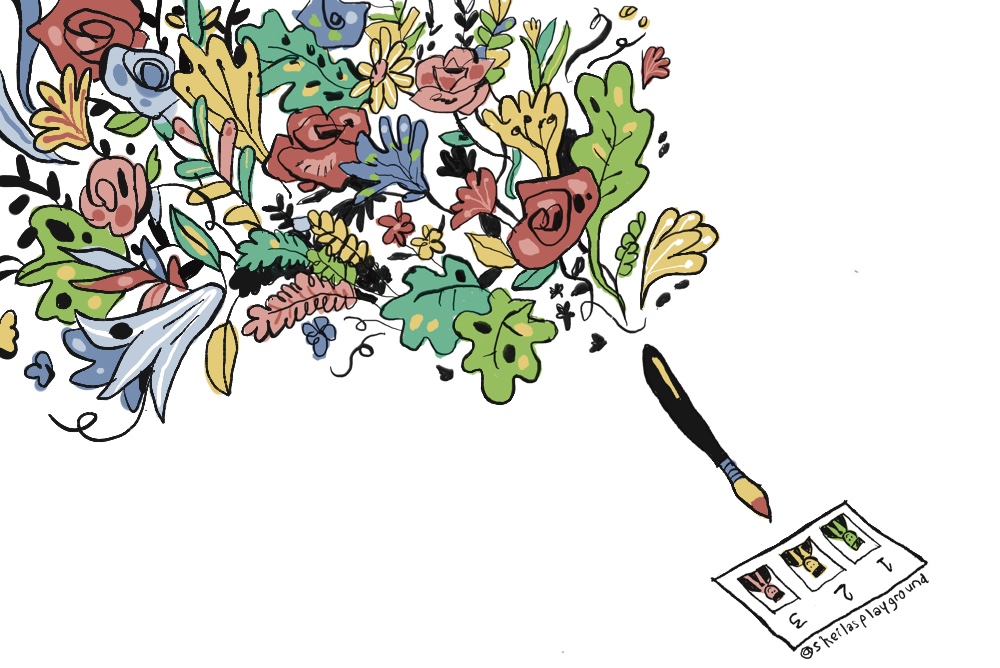
Where are the artists in Indonesia’s election this year? asks Jakarta-based illustrator Sheila Rooswitha Putri in our latest “Election Letter.” Illustration by Sheila Rooswitha Putri.
The absence of art in Indonesia’s presidential election has been noticeable.
Back in 2014, when Joko Widodo—known as Jokowi—campaigned to become the seventh president of this republic, it was remarkable how many of us artists put our creative support behind him. We wrote songs, comics, paintings, poems, and more. The Indonesian artist Hari Prast even made a series of illustrations portraying Jokowi in the style of Tintin, the famous Franco-Belgian comic book. The Tintin-style renderings captured Jokowi’s promise. He was a simple businessman, not a hedonistic politician, who could be an action-oriented problem solver.
Jokowi won that election with 53.15% of the vote.
Artists got involved in politics again in 2017, after a far-right religious group accused then-Jakarta governor Basuki Tjahaja Purnama—known as Ahok—of blasphemy. During his trial, Ahok received an outpouring of artist tributes, and after the court sentenced Ahok to a two-year prison term, artists flooded his prison with thousands of artworks and bunga papan, or flower boards. It was a show of solidarity with Ahok, but also with what he represented for Indonesia’s identity as a diverse nation.
Yet I have not seen artists put their genuine support behind any of the three candidates running in the ninth presidential election this week.
By nature, artists share their thoughts and concerns wholeheartedly without exterior motives. That means when they start to put their support behind a candidate, they communicate a real hope for change. But none of the candidates in the election field have successfully inspired artists.
As a comic artist myself, I am used to scribbling descriptions to convey my characters’ personalities. If I were to do that for this election, here’s what I would include for each of the candidate’s profiles:
Candidate 1) Anies Baswedan, 54: A charming politician and scholar, and formerly an education minister and the governor of Jakarta. He makes a perfect first impression. But during the gubernatorial election in 2017, Anies did not do anything when his zealous followers incited racial hatred toward his rival, the aforementioned Ahok, a non-Muslim candidate. In this period, Anies seemed to aggravate existing polarization in the country. For some people, this makes him an ineligible candidate.
Candidate 2) Prabowo Subianto, 72: An ex-military general accused of human rights violations, who has now attempted to rebrand himself as a cute and chubby cat-loving uncle. Subianto is the son-in-law of Suharto, the late strongman president who reigned over Indonesia for 32 years. After decades in the military, Prabowo was dishonorably discharged in 1998 following allegations of human rights violations in East Timor. Following a self-imposed exile, he returned to Indonesia to form a political party. He has run for president, unsuccessfully, in the past. In 2019, Jokowi—who follows the motto “keep your friends close, and your enemies closer”—named Prabowo his defense minister. In a surprising twist, Gibran Rakabuming Raka, Jokowi’s son, is now running as Prabowo’s vice-presidential candidate.
Candidate 3) Ganjar Pranowo, 55: The ex-governor of Central Java province who has the support of the secular-nationalist political party. A large number of people feel positively about Ganjar’s first presidential election bid. This does not come as a surprise, because Java is the most populated island in Indonesia. However, Ganjar is also backed by the political party founded by Indonesia’s fifth president, Megawati Sukarnoputri—the daughter of Sukarno, the late founding father and first president of Indonesia. The public questions whether his run is serving to advance her political ambitions.
Since election season began, national debates between Candidate 1, Candidate 2, and Candidate 3 have been dominated by personal attacks. The candidates don’t share programs, promises, and real ideas. For instance, I have yet to hear any of them address the crucial issue of protecting women and children, long marginalized, especially in the provinces and the villages. Femicide and child abuse are in the news every single day. Yet none of the candidates has presented any plans to prevent domestic violence, even though we know we need to significantly transform society to end this scourge.
Watching this presidential election makes me think back to 2019, when Jokowi was campaigning for his second presidency. Even my mother, almost 70 years old back then, marched in a massive rally held at Senayan Stadium, the biggest football stadium in all of Jakarta. Hundreds of thousands showed up that day dressed in white to show their support, enough people to blanket a 5-kilometer radius around the stadium. That’s how hopeful Indonesia was back then.
I wish we could feel such hope today. Instead, we watch as Jokowi, having hit his constitutional term limit, now pushes for voters to elect his son vice president. Political dynasties are not uncommon here, but few expected such a move from Jokowi, the most supported politician in Indonesian history, who has spoken out against nepotism in the past.
It’s no wonder art has been absent this year.
I want to write a more optimistic piece about this election, but who am I, if not a hopeless romantic creative worker whose expectations have been broken again and again?
Alas, unfulfilled expectations are what made us artists!




Send A Letter To the Editors